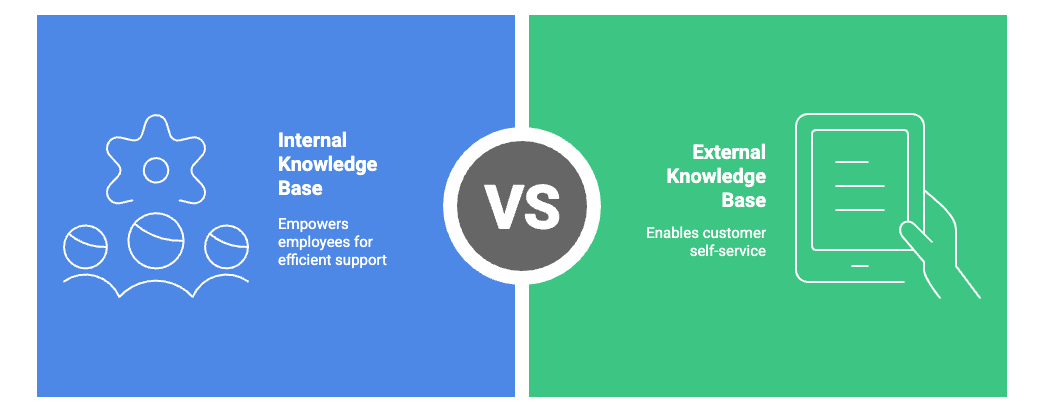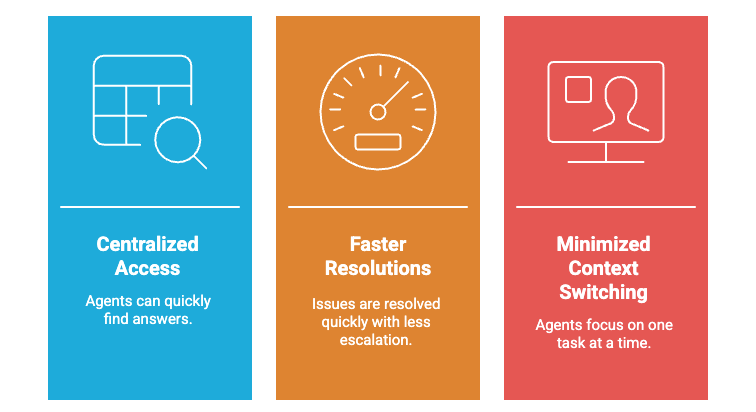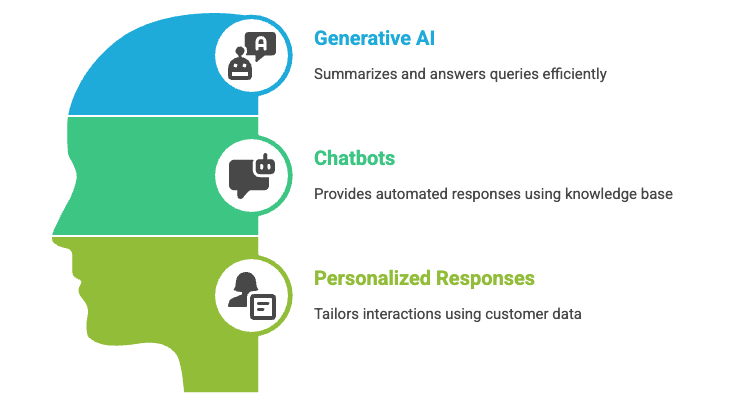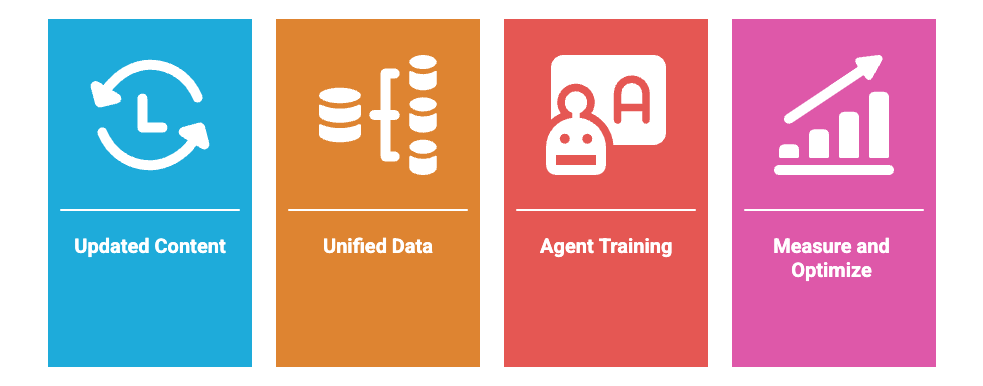Everything you need to know about customer service knowledge management in 2025
Sneha Arunachalam
Sep 04, 2025

“How do I fix this?”
That’s the one question every customer wants answered—fast.
In a world where speed and accuracy define customer loyalty, the real differentiator isn’t just friendly support—it’s knowledge. This is where Customer Service Knowledge Management comes in. It’s not just a library of FAQs or help articles; it’s the engine behind faster resolutions, empowered agents, and self-sufficient customers.
Whether it's internal documentation guiding your support team or external content powering your help center, an effective knowledge system can slash response times, reduce ticket volume, and improve the overall customer experience.
In this blog, we’ll dive into what it is, why it matters, the difference between internal and external knowledge, real-world use cases, how AI is transforming it & much more.
What is customer service knowledge management?
Knowledge management for customer service is pretty straightforward — it's how you collect, organize, and share information across your organization so support teams can actually find what they need.
Definition and core purpose
Customer service knowledge management means making your organization's collective knowledge available to those who need it. This systematic process captures and utilizes your company's information so both employees and customers can solve problems independently and accurately.
The core purpose is straightforward: ensure the right information reaches the right people at the right time. A well-managed knowledge base allows your support representatives to find accurate answers quickly, leading to faster resolution of customer issues. Furthermore, this efficiency not only meets customer expectations but often exceeds them, resulting in higher satisfaction levels.
Think of it like organizing your toolbox. Instead of digging through a messy drawer every time you need a screwdriver, everything has its place. Your team can grab what they need and get back to work.
With a comprehensive knowledge management system, you can:
- Reduce support costs
- Speed up issue resolution times
- Improve customer satisfaction
- Drive new business to your company
Internal vs external knowledge base

Knowledge bases come in two main forms, each serving different audiences with distinct purposes.
An internal knowledge base is designed specifically for employees and internal stakeholders. It typically contains company policies, employee handbooks, training materials, and proprietary data that helps your team perform their jobs better. Moreover, it captures and shares unique experiences and skills across teams that would otherwise be impossible to transfer.
An external knowledge base (often called a help center) serves customers, clients, and the general public. It functions as a self-service hub where users can find FAQs, product guides, troubleshooting tips, and other resources to understand your offerings without contacting support. This approach caters to the 73% of consumers who prefer solving issues independently before reaching out to your team.
The difference matters because your internal team needs different information than your customers do. Your agents might need detailed troubleshooting steps, while customers just want to know how to reset their password.
Why it matters in today's support landscape
The customer service environment has changed dramatically. Businesses now operate globally across multiple sites, languages, and cultures. Consequently, the amount of information organizations handle has grown exponentially, making it nearly impossible to navigate without proper organization.
McKinsey reports that by integrating a Customer Service Knowledge Management system, an agent's search time for answers can be reduced by approximately 35%. This efficiency is crucial because 65% of customers want their problems resolved the first time, while 62% believe knowledgeable employees are the third most important aspect of good customer service.
A well-implemented customer service knowledge management system transforms how your support teams operate by providing quick access to accurate information, reducing response times, and maintaining consistency across all customer interactions. This approach creates a foundation for service excellence that benefits both your organization and your valued customers.
How customer service knowledge management reduces response time

Here's the thing about faster customer service — it's not magic. It's just good organization. A properly set up Customer Service knowledge management system cuts response times across three areas that'll make a real difference for your team.
Centralized access to information
Scattered information kills speed. Without a central knowledge base, agents waste up to 16% of their time jumping between 4-7 different apps while customers wait. That's like asking someone to cook dinner while their ingredients are spread across three different kitchens.
When you centralize everything, the results speak for themselves:
- Agent search time drops
- Teams resolve issues on the first try, which builds customer loyalty
- Everyone gives consistent answers no matter which channel customers use
With centralized information, your agents get immediate access to customer profiles, purchase histories, and troubleshooting guides. No more "Let me put you on hold while I look that up" — the thing customers hate most.
Fewer escalations and faster resolutions
Think about what happens when your front-line agents can't find answers. The ticket gets bounced around, customers get frustrated, and resolution times balloon. Knowledge management fixes this by giving first-line agents the tools they need to solve complex problems themselves.
When agents can access the right answers quickly, they solve problems without transferring customers. Your customers get help faster, and your team feels more confident handling tough questions.
Minimized context switching for agents
Context switching — jumping between unrelated tasks or tools — is productivity poison. The average employee loses five full workweeks annually just from switching contexts. Each switch takes about 23 minutes to fully refocus, and for support agents, this constant tool-hopping creates mistakes and frustration.
Knowledge management tackles this by:
- Providing one streamlined, searchable system instead of multiple platforms
- Reducing the need to manage scattered to-do lists
- Eliminating constant platform switching and supervisor requests
Without proper knowledge management, your agents might spend 20-80% less time on actual productive work each time they switch contexts. But with an effective system, your team stays focused on solving customer problems rather than hunting through disjointed tools.
The combined effect creates a ripple of efficiency throughout your entire support operation. Your team delivers faster resolutions while maintaining the quality standards your customers expect.
4 Key use cases that show real impact of customer service knowledge management

Let's look at what actually works. These aren't theoretical benefits — they're real results from companies that got serious about customer service knowledge management.
AI-powered search for faster ticket handling
Nobody wants to spend half their day hunting for answers. AI-powered search tools reduce agent search time by approximately 35%, and that time savings adds up fast. These systems actually understand what customers are asking, even when they phrase things differently than your documentation.
Spartan Race figured this out. They implemented AI-powered Answer Bot to handle common questions, and the results were immediate: chat volume dropped by 9.5% and they extended live chat availability by three hours daily.
The magic happens because these tools:
- Recognize what users actually mean, not just exact keyword matches
- Suggest relevant articles based on ticket content
- Get smarter from each agent interaction
Your agents spend less time searching and more time solving the problems that really need human attention.
Self-service portals that deflect simple queries
Here's the thing about customers — 61% of them actually prefer solving simple issues themselves. A well-designed portal can deflect up to 70% of routine support queries. That's not just good for your team — it's exactly what customers want.
Self-service works when you give customers:
- Searchable knowledge bases with real troubleshooting guides
- Interactive FAQs that address their actual concerns
- Community forums where customers help each other
Your team gets to focus on complex issues that truly require human expertise. Customers get immediate answers without waiting. Everyone wins.
Knowledge-Centered Service methodology to avoid duplication
Knowledge-Centered Service changes the game by capturing knowledge right when it matters most. Instead of treating every customer interaction like a one-off event, KCS builds your knowledge base through actual support work.
Vend, a retail management software company, nailed this approach. Every agent could create knowledge content, following one simple rule: when tickets come in, either use existing solutions or create new articles.
The results speak for themselves:
- 650% increase in help center articles
- 29% improvement in customer satisfaction
- 40% increase in one-touch problem solving
Companies implementing KCS see better first resolution times. Your knowledge base grows organically through the work you're already doing.
Training new agents with existing knowledge
New hire training gets dramatically easier with a solid knowledge base. Instead of starting from scratch every time, new agents can quickly learn common issues and their solutions.
Knowledge management systems provide consistent training materials covering everything from product details to service best practices. Every new agent gets the same high-quality guidance, regardless of who's doing the training.
Tesco created an internal knowledge base for 460,000 employees across nine countries. This takes pressure off managers by handling repetitive questions that would otherwise eat up training time.
New agents can start contributing value sooner. With documented solutions to common problems, they can resolve customer issues confidently even during their first weeks on the job.
The role of AI and automation in speeding up customer service

AI changes everything we've talked about so far. Where knowledge management gives your team faster access to answers, AI actually starts providing those answers automatically.
Generative AI for summarizing and answering
Traditional chatbots feel like talking to a robot because, well, they are. Generative AI is different — it actually understands context and responds like a human would.
This technology lets businesses:
- Create customized responses and solutions in real-time
- Deliver proactive suggestions and tailored recommendations
- Solve customer issues before they happen
Take this example: a home mortgage company swapped their basic chatbot for a generative AI solution. Suddenly, both customers and reps could get quick, conversational answers to complex questions. No more "I don't understand, please try again."
The results speak for themselves — companies using mature AI report higher customer satisfaction and lower call handling times.
Chatbots using knowledge base content
Here's where it gets interesting. These aren't your typical "press 1 for billing" chatbots. Knowledge base chatbots pull information directly from your repository to answer questions accurately. They work 24/7 and handle the routine stuff so your agents can focus on the complex problems.
The beauty is in the details — these chatbots can walk someone through troubleshooting steps or resolve problems instantly without any human help. Plus, they get smarter over time by learning from past conversations.
No wonder customer care executives are already investing in AI or planning to. They see where this is heading.
Personalized responses using customer data
AI doesn't just respond faster — it responds smarter. The technology examines past behavior and real-time patterns to anticipate what customers need. It uses sentiment analysis to pick up on emotional cues in messages. And it delivers personalized recommendations based on individual preferences.
What's really powerful is how AI evaluates unstructured data like reviews, social media conversations, and service interactions to identify needs and pain points more precisely.
This serves two purposes — customers feel understood while your team can focus on higher-value work. It's a win for everyone involved.
4 Best practices for building a fast-response customer service knowledge management

Building a knowledge system that actually speeds up responses isn't just about dumping information somewhere and hoping for the best. It takes planning, maintenance, and smart choices about how you organize everything.
Keep content updated and relevant
Nothing kills a knowledge base faster than outdated information. When agents find wrong answers, they stop trusting the system entirely. Here's how to keep things fresh:
- Set up a clear process for who reviews and approves changes
- Create update schedules based on how often information actually changes
- Use version control so you can track what's been modified
- Ask users to tell you when something's wrong or unhelpful
Consider this: Customers expect to solve problems using your knowledge base. That means keeping content current isn't a nice-to-have — it's essential for meeting basic expectations.
Unify data sources across departments
Knowledge scattered across different systems creates a massive time sink. Your agents shouldn't need to check five different places to find one answer. A unified knowledge hub:
- Stops agents from wasting time hunting through multiple systems
- Shows you exactly where you have content gaps
- Makes your AI tools way more effective
Start by figuring out where content lives right now — Google Docs, CRMs, random spreadsheets. Then create a single index that respects permissions while making access universal.
Train agents on how to use the system
The best knowledge base in the world won't help if your team doesn't know how to use it. Companies save in training costs when they pair learning management with knowledge systems. Your training should cover:
- How to find information quickly during customer calls
- How to request new articles or suggest edits
- Which resources to bookmark for instant access
- How to attach knowledge base articles to case responses
Make knowledge system usage a key performance indicator for every agent. You can't expect adoption without measuring it.
Measure and optimize with analytics
You need to know what's working and what isn't. Track these key metrics:
- Which articles get viewed most and what people search for
- How long people spend on pages
- Search queries that come up empty
- How knowledge base traffic compares to ticket volume
When your knowledge base traffic exceeds support tickets on the same topic, you know your content is doing its job. Regular analytics reviews help you spot opportunities to make your system even faster.
Conclusion
Customer Service Knowledge Management isn’t just a nice-to-have anymore—it’s the backbone of fast, scalable, and satisfying support. From cutting agent response times to empowering customers through self-service, a well-built knowledge system transforms how your team operates.
The difference lies in having centralized, searchable, and up-to-date information that reduces escalations, boosts first-contact resolutions, and helps new agents hit the ground running.
Add AI into the mix, and it’s a game-changer. With smart search, chatbots that learn, and real-time personalization, support becomes not just faster—but smarter, more human, and more predictive.
At the end of the day, it’s simple:
When your team knows more, they solve more. When your customers find answers, they stay longer.
Build your knowledge management system with intention, and it won’t just reduce response times—it’ll redefine your entire customer experience.
Quick summary: From chaos to clarity: Why customer service knowledge management is your secret weapon
In today's fast-paced business environment, customers demand instant solutions to their problems. Customer Service Knowledge Management emerges as the game-changing solution that transforms how support teams operate, cutting response times dramatically while improving customer satisfaction.
- Centralized information access: Eliminates the time waste of searching across multiple platforms, reducing agent search time
- Reduced escalations: Empowers front-line agents with comprehensive knowledge to resolve complex issues without transferring customers
- AI-powered enhancement: Generative AI and smart chatbots provide instant, contextual responses using knowledge base content
- Self-service success: Well-designed portals deflect up to 70% of routine queries, allowing customers to solve problems independently
- Streamlined training: New agents can quickly access documented solutions and best practices, reducing onboarding time
Customer service knowledge management isn't optional—it's essential for competitive support operations. By centralizing information, leveraging AI capabilities, and empowering both agents and customers with accessible knowledge, organizations can achieve faster resolutions, higher satisfaction rates, and scalable support systems. The result is transformed customer experiences that drive loyalty and business growth.
Frequently Asked Questions
What is customer service knowledge management?is the process of creating, organizing, storing, and sharing information that helps both support teams and customers find accurate answers quickly.
This includes things like:
- Internal resources for agents (e.g., troubleshooting steps, SOPs, product manuals)
- External resources for customers (e.g., FAQs, help center articles, how-to guides)
The main goal is to ensure the right information is available at the right time, which leads to faster issue resolution, fewer support tickets, more consistent responses, and a better customer experience overall.
A company should implement a customer service knowledge management system when:
- Support tickets are repeating frequently (e.g., “How do I reset my password?”)
- Agents spend too much time searching for answers
- New hires struggle with onboarding or consistency
- Customers ask questions that could easily be self-served
- Support quality varies across teams or shifts
- After reaching ~1,000 customers
- Once your support team grows beyond 5–10 agents, or
- When launching new products/services frequently
A knowledge base is a structured, searchable collection of detailed articles, guides, and how-tos designed to help users solve issues independently.
A help center is a broader support hub that often includes the knowledge base, FAQs, contact forms, and other support channels. Meanwhile, an FAQ page is a simple list of commonly asked questions with brief answers—best for quick, high-level information but not ideal for complex issues.
To encourage support agents to contribute, make it easy, rewarding, and part of their workflow. Start by integrating knowledge sharing into onboarding and performance goals. Offer clear guidelines and templates so agents know how to write useful articles. Recognize and reward contributions—through shoutouts, incentives, or internal leaderboards.
Most importantly, create a feedback loop: let agents see how their content helps reduce tickets or improves customer satisfaction. When they feel ownership and impact, they're more likely to participate consistently.
Track usage (article views, active users), content helpfulness (ratings, search success), support impact (ticket deflection, resolution time), and customer satisfaction (CSAT, feedback). Regular content updates and agent contributions also indicate effectiveness.
